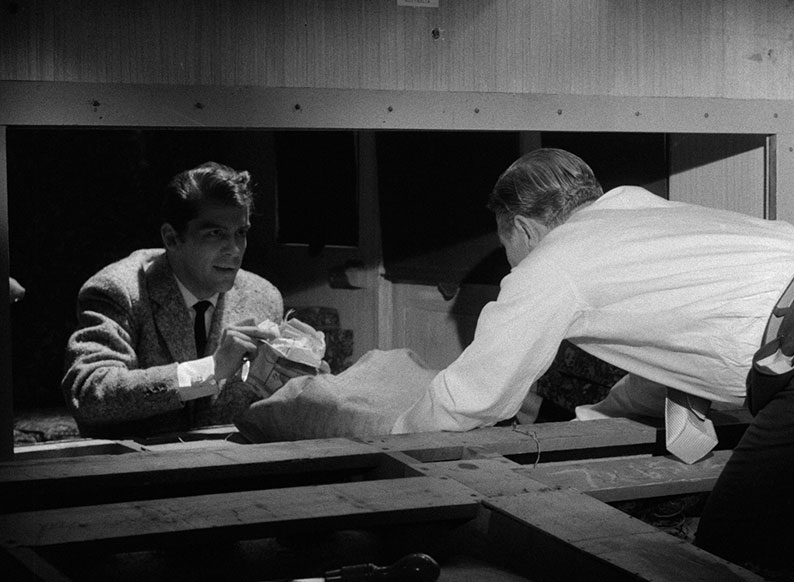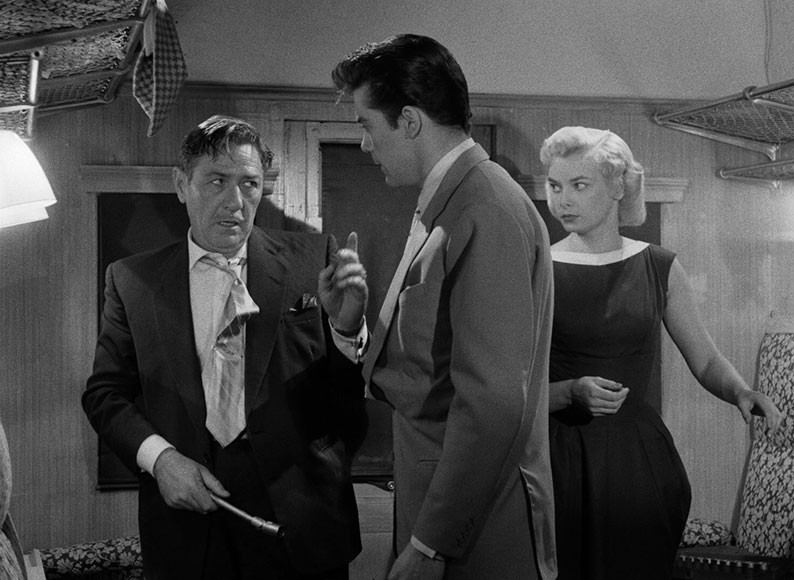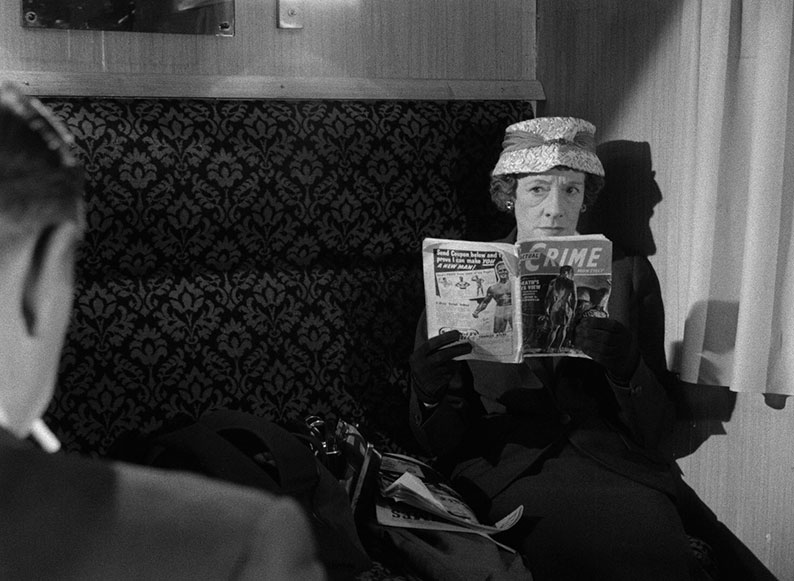But, Mousie, thou art no thy lane
In proving foresight may be vain:
The best laid schemes o' mice an' men
Gang aft agley,
An' lea'e us nought but grief an' pain
For promis'd joy. |
| To a Mouse – Robert Burns* |
Ever since I was first blown away by Jules Dassin’s 1955 crime thriller Rififi, I’ve been a sucker of wordless robbery sequences in movies. In such scenes, the individual members of a criminal gang work like components of a finely engineered Swiss watch, and conversation is unnecessary because everything has been planned and rehearsed to perfection, and everyone knows exactly what they have to do. It’s the antithesis of a movie convention that has always irritated me, the one in which an ingenious robbery is carefully planned, but the gang is saddled with a human weak link who you just know is destined to scupper the whole enterprise. It’s worth keeping both of these tropes in mind when discussing the little-known 1957 British crime movie, The Flying Scot.
It begins brilliantly. As an Edinburgh to London express passenger train prepares to depart, two plain-clothes security men mark the doors of one compartment** with a notice pronouncing that it is not for public use before locking the door. Seconds later, a young man and woman join the train and enter the next-door first class compartment. An older friend who has seen them off approaches a nearby guard, from whom he procures reservation stickers to place on the window and the door of the compartment announcing that the two are just married, which effectively gives them sole occupancy for the entire journey. The friend waves them goodbye, but then unexpectedly also boards the train and heads to a different carriage. Once installed, the newlyweds close the compartment curtains and change their clothes, then make themselves comfortable on opposite seats and catch a little sleep, something the older man also does in his otherwise empty compartment. Something’s clearly afoot, but what?

At a specific point in the journey, the train whistle blows, and all three individuals snap into action. The newlyweds open one of their suitcases and unpack several tools, and the older man sets about unscrewing the bolts that hold the seat onto the wall that separates their compartment from the locked one next door, while the younger two pass tools to him like nurses assisting a surgical procedure. Once this is done, they lower the seat in the adjoining carriage and the younger man climbs through and opens one of the bags, confirming that they are stuffed with money, old notes being transported for secure destruction. As he passes the money through to his companions, they stuff it into bags, which at a key stage of the journey are thrown through the carriage window onto the trackside below, where they are retrieved by a fourth member of the gang. The seats in both compartments are then secured back into place, leaving no evidence of their mode of entry. The older man then returns to his compartment and the couple change clothes, and on arriving in London they exit the train separately. In no time at all, all four are on a plane to a tropical paradise, where they lead a life of luxury on the money they have stolen.
It’s an immaculately staged 12-minute sequence, during which not a word is said (the conversation between the older man and the guard is seen through the train window and is inaudible to us). It’s then that we get the film’s most telling transition, as the tropically dressed younger man stubs out a large cigar in an ornate ceramic clamshell, and the image shifts focus and cuts to a cigarette being stubbed out in a cheap metal ashtray, then the camera pulls back to reveal the same man in a small room with his two male accomplices. “Well that’s the way I see it,” he says to them. “Fool-proof.” I actually applauded at this lovely reveal, but this is also where my main problem with the film began.
Before I get to that, let’s get one thing straight, the 1957 The Flying Scot is a well-made, smartly scripted British B-movie that belies its three-week shooting schedule and insanely low £18,000 budget. As a claustrophobic character study, it’s fascinating, but as a thriller it’s a little handicapped by the fact that from the moment robbery planner Ronnie (Lee Patterson) says the magic words “Fool-proof,” you know it’s doomed to fail. It doesn’t help, of course, that in British and American films of this period, if a character committed a serious crime, then they had to be shown to pay, whether than meant having their collar felt by the police or suffering some unpleasant misfortune that resulted in their death. But given that this was the condition under which all such films were made during this long stretch of moral censorship, this can hardly be a justifiable cause for retrospective complaint. No, my issue when first watching the film stemmed not just from how early in the running time the plan felt doomed to failure, but that there are so many factors working against its success that it borders at times on black comedy. By the halfway mark the question isn’t whether the gang will pull off this daring robbery, but which one – or which combination – of the many potential disruptions to their scheme will ultimately scupper it.

Leading the problem pack is Ronnie himself, who in reality is nothing like the cool operator he portrays himself as in the opening scene, but an irritable hothead who is quickly shown to have not thought things through anything like as thoroughly as he should have. This is made immediately evident by the points raised by older safecracker Phil (Alan Gifford), who’s unsure about aspects of the plan from the start, and has also chosen not to reveal to the others that he’s nursing a stomach ulcer that is on the verge of bursting. Then there’s the train guard (Gerald Case) whom they’re hoping will pay them little heed, but who reveals that he won’t forget these apparent newlyweds in a hurry because it’s his twentieth wedding anniversary that day. A bigger problem is that Ronnie’s slickly visualised plan did not account for other passengers on the train, several of whom have the immediate ring of human spanners just waiting to throw themselves into the works. The most infuriating of these by far is a young boy named Charlie (Jeremy Bodkin), whose useless parents have opposing views on punishment and seem happy to just let this obnoxious child run free and make a nuisance of himself to others. More than once I secretly hoped he’d burst in on Ronnie and his crew and Ronnie would get so angry that he’d pick him up and throw him through the window in one of the cash bags. Mind you, he’s going to have trouble even reaching them now because the seat fixings and the construction of the dividing wall of this carriage are completely different to the ones that he claims to have previously scouted.
I found myself in the odd position of being frustrated by all of these possible disruptions to the robbery whilst at the same time so irritated by Ronnie’s behaviour that I soon stopped hoping that he would somehow beat the odds and at least get clear of the train before it all went tits-up. Although I was definitely more sympathetic to the more experienced and level-headed Phil – particularly when Ronnie is pushing him to the point where it genuinely looks as if the pain from his perforated ulcer might knock him out or even kill him – but the fact that his health is going to be an issue is revealed at the very start of the journey, thereby casting him as that weak link that is the curse of so many movie robberies. In the end, the only one of the gang who remains fully sympathetic throughout is Jackie (Kay Callard), who does what she is asked and is protectively sympathetic to the unwell Phil’s plight when he is being bullied into working by Ronnie. She also features in the film’s most surrealistic visual, when a hole is cut in the seating of the adjoining carriage and she is the only one slim enough to wriggle through, emerging from it like a caterpillar escaping a brightly patterned egg.
What continued to hold my interest is the film’s examination of the Robert Burns-inspired adage about best laid plans, and how even a carefully thought-through criminal enterprise can be potentially scuppered by random events and the smallest change to a single element. Also impressive are the ways that Phil, Ronnie and Jackie improvise their way around each of the problems as they arise, usually unaware that another is just around the corner. When it comes to where these sacks of money would really be stored, and the real-world makeup of the compartment walls, the film does ask us to take a couple of quite sizeable leaps of faith, but where it then shines is in convincing us that if the money was stored in a locked compartment and if the dividing walls of train compartments were constructed as they are the film, then the plan Phil hastily improvises and they all work to execute would absolutely work. Full marks also for not skipping by rendering it as a music-assisted montage, but instead showing at length just how labour-intensive and frustratingly time-consuming it would be to pull off.

If you’re not in the least bothered by the early inevitability of the main story arc and the overload of potential disaster-bringers, there’s much to enjoy and admire in The Flying Scot. It’s briskly directed by bandleader turned filmmaker Compton Bennett, crams a lot into its brief 70-minute running time, and the physical execution of both robberies is immaculately handled. For reasons I can’t fathom, I initially found Stanley Black’s main theme a little annoying, but soon found I couldn’t get it out of my head, and while the American lead characters are all about selling the film to the Transatlantic market, they are at least played by American (Gifford) and Canadian (Patterson and Callard) actors rather than British performers faking dodgy American accents. And despite my gripes about the early predictability of the gang’s downfall, it’s worth remembering that doomed lead characters were a key component of film noir, whose influence on the thrillers of the 1950s and beyond was considerable. Definitely worth seeing for that opening and the subsequent workarounds forced on the gang alone, but if you have a particular fondness for snappily paced 50s British B-movies, it’s a bit of a must.
The result of a new 4K restoration, the 1.37:1 1080p transfer on Studiocanal’s Blu-ray is rather gorgeous. The image is really crisp, with even the fine detail very clearly defined, and the contrast range his been handsomely graded, delivering bright whites that do not burn out, solid blacks with decent shadow detail, and a very attractive greyscale in between. The high quality of the 35mm material shot specifically for the film does tend to make the lower quality stock footage shots stand out, but this is never a major issue. The picture is also spotless and sits rock solidly in frame.
The linear PCM 2.0 mono soundtrack is on par with other films of this vintage and better than some, and although there is little in the way of bass response, dialogue is always clear and there is no distracting background hiss or other evidence of wear. The music can be a touch shrill on the higher notes, hence my first reaction to it, but is otherwise fine.
Optional English subtitles for the deaf and hearing impaired are available.
Interview with Steve Chibnall, Professor of British Cinema (16:40)
Professor Steve Chibnall, author of Quota Quickies and The British B-Movie, provides a brief but useful overview of how and why B-movies first came into being and how they developed in the UK, before focussing specifically on The Flying Scot. It’s here that I learned that the film was shot in just three weeks on a seemingly absurd £18,000 budget, but Chibnall also comments on the actors, the script, the director, the railway film sub-genre, the technical inaccuracies, the reviews, and the similarity of that opening to the robbery in Rififi.

Interview with Barry Forshaw(13:20)
Author of British Crime Film: Subverting the Social Order, Barry Forshaw, (unknowingly) replicates some of the points covered by Steve Chibnall, but expands on some of them by covering in more detail the work and careers of director Compton Bennett, screenwriter Norman Hudis, and actors Lee Patterson and Alan Gifford. He also notes that in spite of what is suggested by the title, the train is not the famed Flying Scotsman, and he describes the film as something of a gem, echoing the words of one of the contemporary reviews read out by Chibnall.
Alternate Opening Sequence (1:18)
Alternative opening credits, with the back-to-basics title The Mail Bag Robbery.
Stills Gallery (0:46)
A rolling gallery containing eight promotional stills.
A well written, niftily made British B-Movie with a superb opening sequence and some standout scenes. Checking around, it looks like I’m almost alone in my frustration at the unwavering inevitability of the main story arc, the multiple and strongly telegraphed potential disruptions, and the hard-to-like lead character, and if these aren’t an issue for you, then in all other respects the film delivers. Studiocanal’s restoration and transfer are both superb, and while the disc is light on special features, the two interviews are both absolutely worth watching.
But Mouse, you are not alone,
In proving foresight may be vain:
The best-laid schemes of mice and men
Go oft awry,
And leave us nothing but grief and pain,
For promised joy!
|